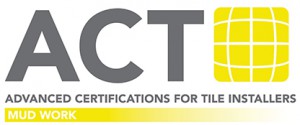Throughout recorded history, humankind has expressed its desire to create beautiful living and working spaces through art. In the near east builders employed decorative tile work in the earliest known structures. Beautiful tiled surfaces are found in the oldest pyramids, the ruins of Babylon and the ancient ruins of Greek cities. Is it any wonder that the developers of properties today would want these tiled surfaces to be installed correctly; to last for the life of the building? Surely not.
Yet with the addition of new products and new installation techniques emerging on a near daily basis, only the highly trained craftsmen and women have the knowledge and the skill required to meet this challenge. This is why the Advanced Certifications for Tile Installers (ACT) program has been created through the combined efforts of five organizations including; the Ceramic Tile Education Foundation (CTEF), the International Masonry Institute (IMI), the International Union of Brick Layers and Allied Craftworkers (IUBAC), the National Tile Contractors Association (NTCA) and the Tile Contractors Association of America (TCAA).
The purpose of the ACT Certification program is to establish a testing mechanism which evaluates the skills and knowledge of tile installers who have been pre-qualified by being either a Certified Tile Installer (CTI) through the Ceramic Tile Education Foundation (CTEF) or a journeyman tile setter who has successfully completed the apprenticeship training program conducted by the International Union of Brick and Allied Craftworkers (IUBAC).
Historically, a tile installer floated cement based mud on walls and floors before the tile was set on these surfaces. The intent was to prepare a flat surface that was in-plane, so that the finished product appeared straight and true. With the advent of new adhesives, many tile installers either never learned how, or over time simply lost the ability, to float a wall with mud. Yet when out of tolerance conditions in a wall or floor substrate scheduled to receive tile are found, the best solution is to install a reinforced mortar bed over the irregular substrate.
The Tile Council of North America (TCNA) Handbook for Ceramic Tile Installation provides a number of details to guide the installer in this effort. Detail W222, for example, details a one coat method to correct typical out of tolerance wall conditions. When the wall substrate is severely out of tolerance, TCNA detail W221 permits twice the mortar thickness to correct these abnormal wall conditions.
Concrete slabs installed pursuant to concrete industry standards are generally not flat enough for floor tile – whether ceramic or stone. The concrete often curls at joints and at the end of slabs. The floor tolerance required by the tile industry when using tile smaller than 15″ on any one side is ¼” in 10 feet. A typical concrete slab will not meet this tolerance. Large format tile (any one side over 15 inches) presents an even greater problem, as the required tolerance for flatness is 1/8″ in 10 feet. The average concrete substrate simply will not meet this standard. The solution is to float out the floor with a mortar bed designed for the particular conditions presented.
The Advanced Certification for Tile Installers (Mud Work) is designed to test the installer on his or her knowledge in these areas, and to certify those installers with the skill to properly float a wall or floor so that the substrate is appropriate for the application of tile. Those installers who successfully complete the ACT Mud Work testing will gain the distinction of being an ACT certified Mud Work specialist.


